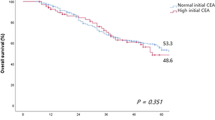Abstract
Background
To analyze the causes and patterns of unexplained carcinoembryonic antigen (CEA) elevation after curative treatment in locally advanced rectal cancer patients.
Methods
Among the 1309 locally advanced rectal cancer patients treated with curative resection and radiotherapy between January 2001 and June 2011, 325 patients who postoperatively developed abnormal CEA elevation were reviewed. The unexplained CEA elevation was defined as a CEA level higher than 5 ng/mL with no evidence of cancer recurrence at the time of elevation.
Results
Of the 325 patients, 143 (44%) had unexplained CEA elevations. The causes were categorized as delayed recurrence (n = 29, 20%), non-colorectal malignancy (n = 10, 7%), and non-malignancy-related conditions (n = 104, 73%). Shorter intervals between treatment and the first CEA elevation, and a higher peak CEA level, were observed in the delayed recurrence group compared with the non-colorectal malignancy or non-malignancy-related group (intervals of 6.8 vs. 44.9 vs. 23.2 months, respectively, p = 0.002; and peak CEA levels of 9.9 vs. 7.1 vs. 6.2 ng/mL, respectively, p = 0.034). In patients who showed delayed recurrence, the interval between the first CEA elevation and diagnosis of recurrence was a median of 13.0 months (range 3.8–60.6 months). Smoking was the most common cause for non-malignancy-related conditions. The patterns of unexplained CEA elevations were defined as sporadic (n = 78, 55%), stationary (n = 37, 26%), and increasing (n = 28, 20%). The patterns were significantly different depending on the cause (p < 0.001).
Conclusions
Analysis of the patterns of unexplained CEA elevations is a reasonable approach to predict the cause of the cancer.

Similar content being viewed by others
References
Gold P, Freedman SO (1965) Demonstration of tumor-specific antigens in human colonic carcinomata by immunological tolerance and absorption techniques. J Exp Med 121(3):439–462
Compton CC, Fielding LP, Burgart LJ et al (2000) Prognostic factors in colorectal cancer: College of American Pathologists Consensus Statement 1999. Arch Pathol Lab Med 124(7):979–994
Park S-H, Kim J-C (2016) Preoperative chemoradiation for locally advanced rectal cancer: comparison of three radiation dose and fractionation schedules. Radiat Oncol J 6(2):96–105 34(
Yoon SM, Kim DY, Kim TH et al (2007) Clinical parameters predicting pathologic tumor response after preoperative chemoradiotherapy for rectal cancer. Int J Radiat Oncol Biol Phys 69(4):1167–1172
Kim YJ, Park SC, Kim DY et al (2012) No correlation between pretreatment serum CEA levels and tumor volume in locally advanced rectal cancer patients. Clin Chim Acta 413(3–4):511–515
Duffy MJ, van Dalen A, Haglund C et al (2007) Tumour markers in colorectal cancer: European Group on Tumour Markers (EGTM) guidelines for clinical use. Eur J Cancer 43(9):1348–1360
Litvak A, Cercek A, Segal N et al (2014) False-positive elevations of carcinoembryonic antigen in patients with a history of resected colorectal cancer. J Natl Compr Cancer Netw 12(6):907–913
Greene FLPD., Fleming ID, Fritz AG, Balch CM, Haller DG, Morrow M (2002) American Joint Committee on Cancer. Colon and rectum. AJCC cancer staging manual, 6th edn. Springer, New York, pp 113–123
Moertel CG, Fleming TR, Macdonald JS, Haller DG, Laurie JA, Tangen C (1993) An evaluation of the carcinoembryonic antigen (cea) test for monitoring patients with resected colon cancer. JAMA 270(8):943–947
Stevens D, Mackay I, Group BPS (1973) Increased carcinoembryonic antigen in heavy cigarette smokers. The Lancet 302(7840):1238–1239
Stockley RA, Shaw J, Whitfield AG, Whitehead TP, Clarke CA, Burnett D (1986) Effect of cigarette smoking, pulmonary inflammation, and lung disease on concentrations of carcinoembryonic antigen in serum and secretions. Thorax 41(1):17–24
Go VL (1976) Carcinoembryonic antigen: clinical application. Cancer 37(1 suppl):562–566
Loewenstein MS, Zamcheck N (1978) Carcinoembryonic antigen (CEA) levels in benign gastrointestinal disease states. Cancer 42(3 Suppl):1412–1418
Kwon YJ, Lee HS, Shim JY, Lee YJ. Serum carcinoembryonic antigen is positively associated with leukocyte count in Korean adults. J Clin Lab Anal. 2017;e22291
No J-I, Yang J-Y, Hyun HJ, Yeon CS, Choi H-J (2013) Factors associated with serum levels of carcinoembryonic antigen in healthy non-smokers. Korean J Fam Med 34(6):413–419
Acknowledgements
This work was supported by a National Cancer Center Grant (NCC-1510160 & NCC-1610440).
Author information
Authors and Affiliations
Contributions
SUL: Data curation, methodology, project administration, formal analysis, writing—original draft, and writing—review and editing. EJ: Data curation, methodology, project administration, formal analysis, writing—original draft, and writing. SUL and EJ contributed equally to this study. DYK: Responsible for overall content, conceptualization, formal analysis, funding acquisition, software, and writing—review and editing. THK: Writing, reading, supervision and approval of article. JYB: Writing, investigation, reading, and approval of article. YC: Writing, investigation, reading, and approval of article. HJC: Writing, investigation, reading, and approval of article. JHO: Writing, investigation, reading, and approval of article.
Corresponding author
Ethics declarations
Conflict of interest
All authors state that there are no conflicts of interest
Ethical approval
The study was conducted in accordance with the ethical principles of the Declaration of Helsinki and the International Conference on Harmonization guideline E6: Good Clinical Practice.
About this article
Cite this article
Lee, S.U., Jwa, E., Kim, D.Y. et al. Analysis of unexplained carcinoembryonic antigen elevation after curative treatment of locally advanced rectal cancer. Int J Clin Oncol 23, 924–929 (2018). https://doi.org/10.1007/s10147-018-1293-4
Received:
Accepted:
Published:
Issue Date:
DOI: https://doi.org/10.1007/s10147-018-1293-4




